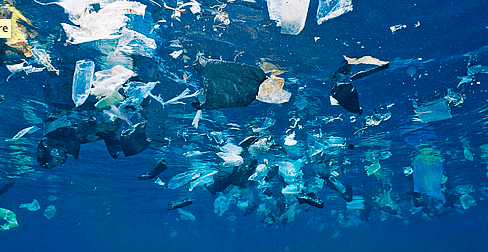
According to current predictions by the World Economic Forum, plastic debris in the ocean will outweigh the ocean’s fish by the year 2050. If you’re like me, this statistic is startling. More plastic than fish in our vast oceans? That seems so unnatural, so absurd, that it was hard to wrap my head around that projection when I first heard it at my internship this summer at a coastal conservation organization. But at the same time, I look around myself and all I see is plastic— we wear plastic; our food is packaged in plastic; we drive cars made increasingly out of plastic to stores to buy more things made of plastic. The World Economic Forum study found that about one third of our plastic waste is not disposed of properly. Not surprisingly, quite a bit of plastic ends up drifting in the great blue ocean forming huge patches of garbage and messing with our lives and the lives of the ocean’s creatures.
The effects of marine plastic pollution on wildlife are life threatening. Photographs of creatures caught up and trapped in plastic debris are numerous. Current studies find that at least half of the world’s sea turtles and ninety percent of seabirds have consumed plastic, which can kill them by blocking digestive tracts or piercing intestinal walls. And, animals that eat too much plastic can starve because their stomachs are too full of plastic to feel hungry.
Marine plastic pollution is not only a threat to the health of marine wildlife, but also to the livelihoods of fishermen, ways of life for coastal communities, and human health. Plastic pollution threatens already overfished fish stocks, causes damage to fishing vessels, and is aesthetically unattractive, all of which result in income losses for many coastal communities. A plastic threat that is getting more and more recognition is microplastics. Plastic never really disappears, but decomposes into tiny pieces of plastic that fish and shellfish eat. These microplastics attract and attach to chemical pollutants. When we eat these animals, we ingest these microplastics and the chemicals that attach to them. Studies have found that health effects, like infertility and genetic disruption, occur in fish due to these microplastics. There is fear among scientists that if humans ingest enough, similar effects might occur to us.
Marine plastic pollution poses a global, interconnected threat to our livelihoods, ways of life, health, and the health of marine wildlife. But at the same time, we are producing and dumping more and more plastic into the oceans every year. How can we begin to move towards realizing a future where plastic does not saturate our oceans? Is it possible to have plastic-free oceans when plastics are constantly breaking down into microplastics? How much of a threat are these microplastics to our health? Will this problem be solved through political means, changes in our behavior as consumers, or changes in the behavior of corporations? Through a series of case studies highlighting the importance of change on all three levels- consumer, corporate, and political- I will explore how, as a world connected by our ocean’s currents, we can begin to tackle the issue of marine plastic pollution.